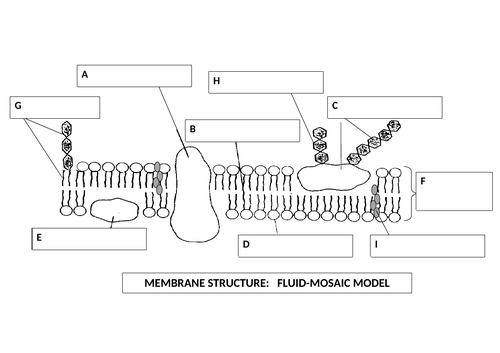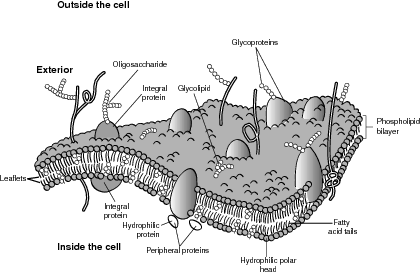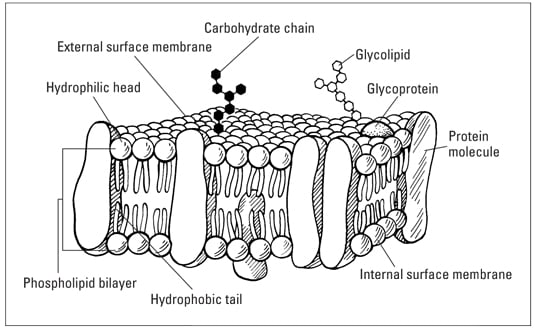The fluid mosaic model is a widely accepted model of membrane structure that explains the organization and behavior of the lipid bilayer, which is the primary component of biological membranes. The model was first proposed by S.J. Singer and G.L. Nicolson in 1972, and has since been refined and supported by a wealth of experimental evidence.
The fluid mosaic model suggests that the lipid bilayer is composed of a mosaic of different lipids, including phospholipids, cholesterol, and other lipids, that are arranged in a fluid manner. These lipids are arranged in a double layer, with their hydrophobic tails facing inward and their hydrophilic heads facing outward. The hydrophobic tails are nonpolar and are therefore resistant to water, while the hydrophilic heads are polar and are attracted to water.
This arrangement of lipids in the bilayer allows for the formation of a barrier that separates the inside of the cell from the external environment. The hydrophobic tails of the lipids form a barrier that prevents the passage of water-soluble substances, while the hydrophilic heads allow for the selective passage of certain ions and molecules through channels and pumps.
In addition to lipids, the fluid mosaic model also proposes that proteins are an important component of the membrane. These proteins are embedded in the lipid bilayer and can perform a variety of functions, such as transporting molecules across the membrane, recognizing and binding to specific molecules, and signaling to other cells. These proteins are highly dynamic and can move within the lipid bilayer, allowing for the fluid nature of the membrane.
One of the key features of the fluid mosaic model is its ability to explain the dynamic nature of biological membranes. The lipids and proteins in the membrane are constantly moving and rearranging, allowing for the rapid response of the cell to changes in its environment. This dynamic nature is crucial for the proper function of cells and is essential for maintaining homeostasis within the body.
In summary, the fluid mosaic model is a comprehensive model of membrane structure that explains the organization and behavior of the lipid bilayer. It highlights the importance of lipids and proteins in the formation and function of biological membranes, and highlights the dynamic nature of these membranes. This model has been widely accepted and has had a significant impact on our understanding of cell biology.
What Is The Fluid Mosaic Model Of Membrane Structure?

The phospholipid bilayer is made of two layers of phospholipids Cholesterol Cholesterol is a steroid lipid that is small and ring shaped. Singer, Protein conformation in cell membrane preparations as studied by optical rotatory dispersion and circular dichroism, Proc. Cholesterols, a type of steroids, are responsible for regulating membrane fluidity and flexibility. Other proteins can be found only on the surface of the cell or in the cytosol, as is the case with estrogen receptors, called peripheral proteins. The phospholipids with long hydrocarbon chains have increased hydrophobic interactions with neighboring lipids and thus decreased membrane fluidity.
According to the fluid mosaic model of membrane structure, protei...

Nicolson, The fluid mosaic model of the structure of cell membranes, Science 175, 720, 1972. What did Engelmann conclude about the congregation of bacteria in the red and blue areas? The plasma membrane is made up of lipids, in a bilayer and within the cell membrane. The glycocalyx is highly hydrophilic and attracts large amounts of water to the surface of the cell. The thickness of plasma membranes can range anywhere from 5 to 10 nm. A model that explains the structure of the membranes that surround cells. The freshly synthesized proteins are transported to the lms, inside of the ER, where they can get down to be modified into their complex form. Some carbohydrates in the mosaic also play essential roles as markers allowing cells to distinguish between self i.
THE FLUID MOSAIC MODEL OF THE STRUCTURE OF CELL MEMBRANES

Describe The Fluid Mosaic Model Of Membrane Structure Biology The fluid Mosaic theoretical account of membrane construction is a cell membrane that behaves like a two- dimensional liquid of assorted composing. Singer and Garth L. Fluid Mosaic Model Definition The fluid mosaic model is one way of understanding biological membranes, consistent with most experimental observations. You might be interested: How To Make A Mosaic Of Pictures? Thompson, Transbilayer exchange of phosphatidylethanolamine for phosphatidylcholine and Nacetimidoylphosphatidylethanolamine in single-walled bilayer vesicles, Biochemistry 14, 4826, 1975. Fortier, The effect of anti-ATPase antibodies upon the Ca+ transport of sarcoplasmic reticulum, Biochem. The polar portion occurs outside.
Describe The Fluid Mosaic Model Of Membrane Structure Biology Essay Example

The fluid mosaic model is applicable to most biological membranes, such as plasmalemmal and intracellular membranes, including the membranes of different cell organelles, such as mitochondria and chloroplasts. The membrane is fluid, but also has an underlying structure, being anchored to the cytoskeleton. The proportions of proteins, lipids, and carbohydrates in the plasma membrane are different from cell types. The membrane must be flexible and able to bend with the cell. Therefore, the response that should be chosen is B.








